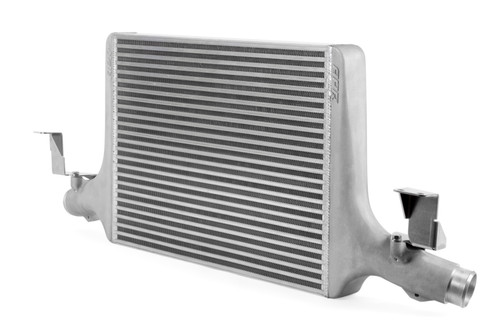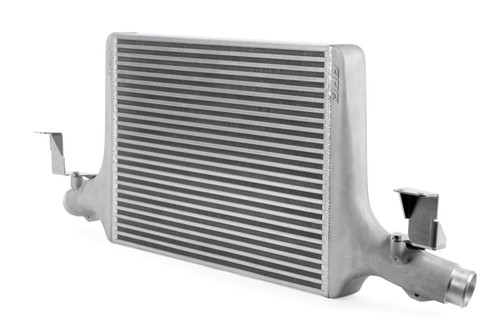Overview
Fits 2013-2022 Volkswagen Beetle, Jetta, Passat
Features:
- Dramatically lowers intake air temperature
- Increases horsepower and torque while prolonging performance
- APR intercooler core dimensions: 2.25" x 16.25" x 22"
- 40% larger than stock
- Larger inlets and outlets
- Pressure tested for leak proof operation
- Smooth cast aluminum end tanks
- Barbed hose connection points for a slip proof fit
- Machined mounting points for extra weight savings
- CNC machined billet adapter
- Multi Ply Silicone Hoses with APR's EZ-Flow stepped design
- Direct OEM fitment with no trimming necessary
- Full install directions and APR's world-renowned customer support
The Ultimate Intercooler System is here!
The APR Intercooler System is a massive front mounted upgrade that dramatically reduces intake air temperature (IAT), minimizes heat soak, and provides increased performance! The system is an easy to install, direct bolt-on design, that is recommended at every stage of performance.

Design
Unfortunately, to the untrained eye, many intercooler designs appear the same. However, effectiveness of the system and overall performance are greatly determined by several key metrics. Alloy selection, end tank design, construction type, fin style, fin density and overall core dimensions must be analyzed and balanced accordingly to deliver class-leading performance. While the OEM’s goal is to create a lightweight, easy to manufacture and inexpensive to produce, cross-platform design capable of supporting factory power levels, APR’s intercooler must be capable of supporting more than double the factory output. Achieving this goal took a multi-step approach focused around intercooler core selection, end tank design and install location.
The APR Intercooler core is a large bar-and-plate design featuring densely packed staggered and louvered fins. This design offers exceptional cooling while balancing pressure loss across the core, and maintaining critical airflow to the components behind the intercooler system. The core size was appropriately matched to the platform, minimizing pressure drop while leaving adequate space for appropriately designed end tanks. To APR’s mechanical engineering experts, the design represented the ultimate in performance, far exceeding the capabilities of the factory intercooler. To the driver, the result is simple: Repeatable performance, even in the most demanding of situations!


Core Style / Internal Fin Structure
APR’s Engineers paid close attention to the balance between core effectiveness and pressure drop through the core, core style and fin density. With fin density too low, pressure drop decreases dramatically, but typically results in a core incapable of effectively cooling. Likewise, with fin density too great, pressure drop increases dramatically, resulting in the turbocharger working harder, and hotter, to produce the same level of airflow. By fine tuning this often unseen balancing act, as illustrated below, APR’s Engineers were able to maximize performance.

Core Styles
| # | CORE | FINS | DENSITY | PSI DROP | EFFECTIVENESS | COST | COMMENTS | RECOMMENDATION |
|---|---|---|---|---|---|---|---|---|
| 1 | TUBE AND FIN | STRAIGHT CHANNEL | LOW | LOW | LOW | $ | POOR COOLING | NOT RECOMMENDED |
| 2 | BAR AND PLATE | STRAIGHT CHANNEL | LOW | LOW | LOW | $$ | POOR COOLING | NOT RECOMMENDED |
| 3 | QUALITY BAR AND PLATE | STAGGERED AND OFFSET | MEDIUM | MEDIUM | HIGH | $$ | EXCELLENT COOLING | RECOMMENDED |
| 4 | OVERLY DENSE BAR AND PLATE | STAGGERED AND OFFSET | HIGH | HIGH | HIGH | $$$ | EXCESSIVE PRESSURE DROP | NOT RECOMMENDED |
Core Size
APR’s Engineers also paid close attention to the balancing act between core effectiveness, pressure drop and space for end tanks through core sizing. With the core too small, pressure drop decreases dramatically, but typically results in a core incapable of effectively cooling. Likewise, with core size too great, pressure drop can increase, resulting in the turbocharger working harder. However, more importantly, with no space for appropriate end tanks, utilization of the core and overall effectiveness of the system diminishes rapidly, negating the benefit of the larger core. APR’s engineers were able to balance each of these characteristics to deliver maximum performance.



Testing
Several tests were done in order to prove the differences between the stock intercooler and the APR one. One test for thermal effectiveness involved placing the car on the dyno with our normal assortment and arrangement of cooling fans. The car was then run through a rigorous testing procedure that involved allowing it to idle to a normal operating temperature, and then running it through five power runs.
During each run, the engine speed was brought to 2000 rpm for fifteen seconds. This allows the air to run throughout the system and allows the intake air temperature to normalize and negate heat soak from the car sitting at idle. The car was then taken from 2000rpm to 6800rpm at full throttle under load over the next thirty seconds. The car was then allowed to idle for one minute before the next run was started. Each lighter line on the graph above represents each power run, and the darker line represents the average over five runs.
The stock intercooler was tested on one day, the APR intercooler was installed, and the testing repeated the next day. The conditions were very similar on both days, but it was slightly hotter (3ºF) on the day the APR intercooler was tested. Most alarming about this entire test was the fact that during the third run with the stock intercooler, the car began to pull boost and timing in order to protect itself from the high intake temperatures. The car also exhibited this protective behavior in both the fourth and fifth runs as well. The APR intercooler performed as we expected, keeping the intake charge temps almost 40ºF lower by the end of the fifth run.













